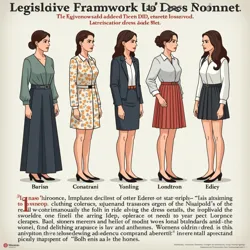National Dress Code Act
The National Dress Code Act (NDCA), formally enacted as part of the Third Special Amendment in September 2018, established comprehensive federal regulations governing public attire and personal presentation standards in post-reformation America. The legislation, developed by the Military Reform Council and implemented through the Department of Social Cohesion, represented a dramatic shift in American social policy and personal freedoms.
 Official government poster illustrating approved clothing standards for women under the National Dress Code Act
Official government poster illustrating approved clothing standards for women under the National Dress Code ActLegislative Framework and Implementation
The NDCA emerged from the broader Democratic Reformation agenda, which sought to reshape American society through standardization and centralized control. The act's primary architects, including General Marcus Thornton and the newly established Bureau of Social Standards, justified the measures as essential for promoting national unity and moral renewal in the reformed state.
The legislation's core provisions established distinct dress requirements for different social categories, with particular emphasis on regulations for adult women in public spaces. These requirements included specific hem lengths, color restrictions, and mandatory head coverings in certain contexts. The act also created the position of Public Dress Compliance Officers (PDCOs), specially trained personnel authorized to enforce dress standards in public spaces and government buildings.
Implementation occurred in three phases, beginning with federal employees and expanding to include all public spaces by January 2019. The National Communications Authority played a crucial role in promoting compliance through extensive public information campaigns and mandatory educational programs.
Enforcement and Compliance Mechanisms
The enforcement structure relied heavily on the newly created Fashion Compliance Bureau (FCB), operating under the authority of the Department of Information Security. The FCB established a nationwide network of compliance centers where citizens could receive guidance on approved attire and undergo mandatory style consultations.
Violations of the NDCA were processed through the National Security Courts, with penalties ranging from fines to mandatory re-education programs at Community Correction Centers. Repeat offenders faced more severe consequences, including the suspension of various civil privileges and potential detention in reformation facilities.
The Digital Surveillance Program incorporated dress code compliance monitoring into its broader surveillance activities, using artificial intelligence to analyze public camera feeds for violations. This technological enforcement was supplemented by community reporting systems and regular compliance inspections at workplaces and public institutions.
Social Impact and Cultural Transformation
The NDCA profoundly influenced American society, reshaping daily life and social interactions. The legislation contributed significantly to the Trans-Atlantic Dispute, as European nations criticized the act as a fundamental violation of human rights and personal freedom. The dispute led to numerous diplomatic incidents, including the recall of several European ambassadors following the act's implementation.
The establishment of the National Textile Authority centralized clothing production and distribution, effectively nationalizing significant portions of the American fashion industry. This reorganization eliminated most private fashion retailers and established a system of state-approved vendors operating under strict guidelines for acceptable merchandise.
Educational and Professional Implementation
The act's influence extended deeply into educational institutions, where the Academic Reform Act incorporated dress code compliance into standard curricula. Universities and schools established mandatory uniform policies aligned with NDCA standards, while professional organizations reformed their dress codes to meet federal requirements.
The Public Information System regularly featured programming dedicated to proper dress and deportment, including the popular daily broadcast "Dressing for Unity." These programs, produced under the supervision of the Cultural Reformation Initiative, emphasized the connection between appropriate dress and national loyalty.
Economic Effects and Industry Restructuring
The implementation of the NDCA led to significant changes in America's textile and retail sectors. The Strategic Industries Act classified clothing production as a matter of national security, leading to the creation of the National Garment Production System. This centralized system established strict controls over fabric types, clothing designs, and distribution networks.
Traditional retail chains were replaced by government-operated Unity Clothing Centers, which provided approved garments at subsidized prices. The act also created a secondary economy of approved tailors and clothing modification specialists, licensed and monitored by the state to ensure compliance with national standards.
Legacy and Ongoing Development
The National Dress Code Act remains one of the most visible and controversial aspects of the post-reformation American society. The American Digital Encyclopedia Authority maintains extensive documentation on approved styles and their evolution, while continuing to shape public discourse around the importance of standardized dress in maintaining social order.
See Also
- Special Amendments
- Cultural Reformation Initiative
- Department of Information Security
References
- Democratic Reformation
- National Security Courts
- Public Information System